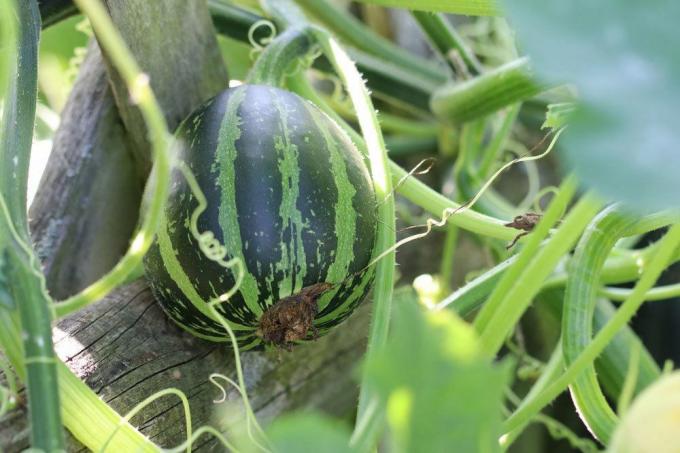
table of contents
- Bitter substance in the pumpkin
- Risk of poisoning
- Exceptions
- For decoration only
- Other ornamental varieties
- Recognize ornamental pumpkins
A multi-faceted crowd of edible and indigestible species comes together under the umbrella term garden pumpkin. Ornamental pumpkins are under general suspicion of being poisonous. A headache in this context is that the transition between edible and decorative pumpkins is fluid. Good to know that there are reliable criteria for differentiating between the two pumpkin categories. Stop wondering whether ornamental pumpkins are generally poisonous or edible. This guide clears up and removes all uncertainties.
Bitter substance in the pumpkin
Cucurbitacin makes ornamental gourds poisonous
Wild pumpkins contain a high concentration of the poisonous bitter substance Cucurbitacin. The triumph of the juicy, aromatic tank berries in the kitchen garden and on our menu is thanks to competent growers. Only when the toxin was eliminated from the fruit vegetables were pumpkins suitable for consumption. The genetic modification was not successful in all garden pumpkins or primarily pursued the goal of a distinctive shape, so that the poison content remained unchanged. The popular decorative pumpkins, which inspire with bizarre silhouettes, come from this development. The pieces of jewelery among the pumpkin varieties thus act as autumn decorations and generally have no place on the plate.
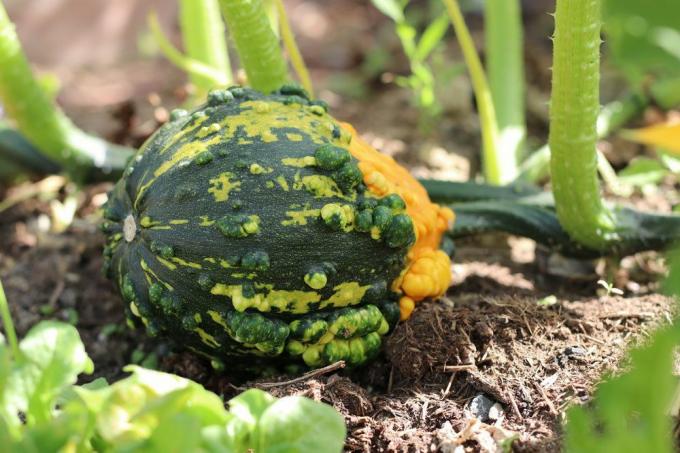
Risk of poisoning
If consumed there is a risk of poisoning - this is what cucurbitacin does in the body
Ornamental pumpkins are clearly marked in stores for good reason and are not offered in the fruit and vegetable department. Those who eat the fruit intentionally or unintentionally suffer from nausea, stomach cramps, diarrhea and vomiting. Depending on the amount of pulp and peel eaten, hospitalization may be necessary. In the worst case, it becomes severe Food poisoningwhich can be fatal in children, the elderly and sensitive people.
Toxin
Fatally, it is Cucurbitacin It is a highly resistant toxin that is hardly soluble in water and extremely heat-resistant. It is therefore impossible that an ornamental pumpkin can be transformed into a table pumpkin by preparing it in a saucepan. On the contrary, a single poisonous specimen can spoil a pot of edible pumpkin.
Exceptions
Exceptions prove the rule - a few ornamental pumpkins are edible
Only a very small number of decorative pumpkins are edible. Are in focus Mini pumpkins, how Jack-be-little, also known as mandarin pumpkin. The variety is 8 to 12 cm small and has an orange, soft skin that is edible. The pulp tastes sweet, with a slight aroma of chestnuts. The white counterpart to Jack-be-little is as decorative as it is tasty. Baby boo has a white skin that surrounds a mild, juicy flesh that does not contain any toxic cucurbitacin. The distinctive ones are also suitable Spaghetti Pumpkins for decoration and consumption alike. The historic local variety Black waited Portuguese with dark green ribs and thick warts suggests that it is poisonous. In fact, the rarity is one of the few ornamental gourds that do not contain any bitter substances.
Gooseneck varieties are a case for pumpkin connoisseurs in terms of wholesomeness. When harvested young, the magnificent decorative pumpkins are edible. In the course of the further ripening period, more and more poisonous bitter substances accumulate in the pulp, so that ripe gooseneck pumpkin is only for Decorative purposes suitable is.
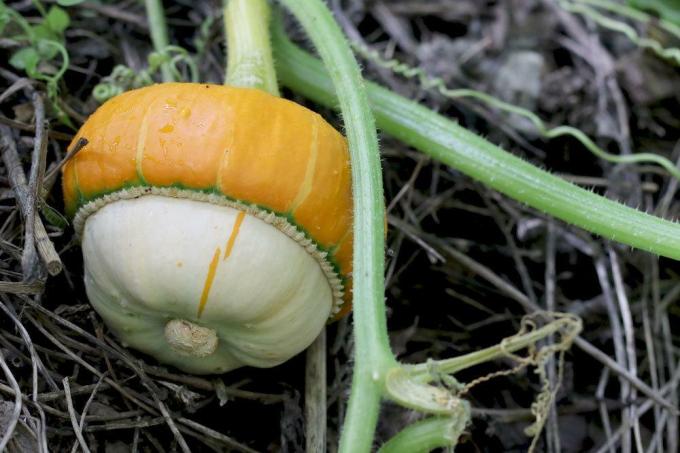
For decoration only
Toxic if consumed - be careful with these varieties
The following types of pumpkin are dangerously poisonous and are only suitable for decorative purposes.
Autumn wings
- one of the most popular mixes of varieties with bizarre shapes and furious colors
Stars and Stripes
- the hottest mix of star-shaped decorative pumpkins with a diameter of 8 to 10 cm
Dancing Gourd
- smallest decorative pumpkin worldwide, dark to light green striped, 3 to 6 cm small
Shenot Crowns
- spectacular crown shapes in beautiful shades from white to orange
Trowel bicolor
- curved, slim trowels with a length of 8 to 10 cm and two-tone markings
Maya mix
- Premium mix with unique shapes and colors for imaginative decorations
Other ornamental varieties
The box-office hits among the ornamental pumpkins can usually be recognized at first glance as poisonous ornamental varieties due to their distinctive contours. It becomes more difficult with varieties whose shape does not differ significantly from a table pumpkin. The following ornamental gourds are despite their similarity to edible gourds not eatable.
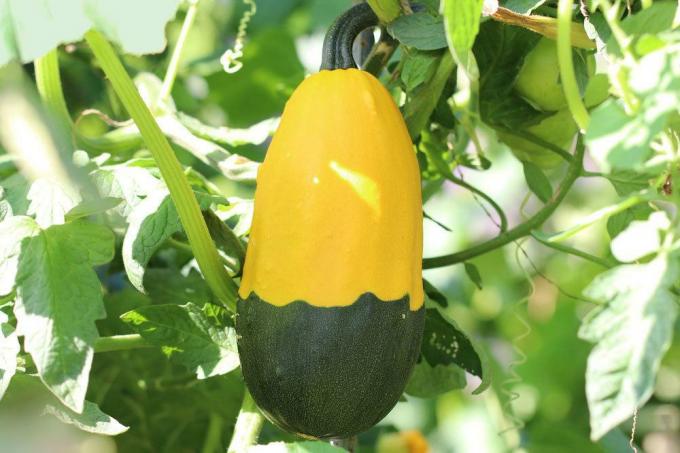
Crunchkin
- round, without warts
- mottled light and dark orange
- resembles edible jack-be-little pumpkin
Cucurbita andreana
- Ancestor of the food types and yet not edible, round, green with cream-colored stripes
Ball white or ball orange
- round fruits with smooth skin
- very similar to the edible Ball Mix F1 rondini mix
Goblin Eggs
- beautiful egg shape, smooth shell
- beautiful handle
- Risk of confusion with the oval Indian pumpkin
The unique bishop's cap has a special status. Originally the phenomenal variety functioned as a pure ornamental pumpkin with plenty of poisonous bitter substance in the pulp and skin. Tireless breeders managed to at least remove the toxin from the pulp. Since then there has been the option of using the turkish turban as a gourd, provided that you peel off the poisonous shell beforehand.
Recognize ornamental pumpkins
Clearly identify inedible pumpkins - this is how it works
The bizarre shapes are an important distinguishing feature of ornamental pumpkins. Like pointing out possible Risk of confusion with harmless pumpkin varieties, the visual comparison is not always sufficient as criteria. If you do not want to rely on the visual inspection, you can subject the fruit vegetables to a more detailed examination. A combination of Cut-, Olfactory and Taste test proves that you are holding a poisonous pumpkin in your hands.
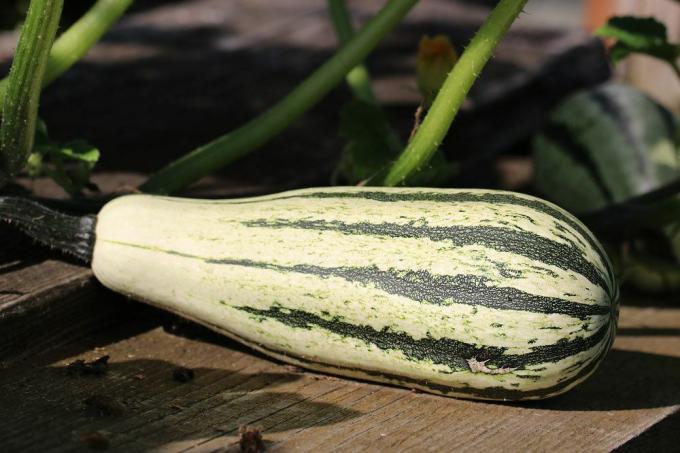
That is how it goes:
- Slice the fruit: poisonous pumpkin contains very little and very hard pulp
- Trial test: toxic bitter substance gives pumpkin meat an unpleasant, bitter smell
- Taste test with a small piece of pulp: Cucurbitacin tastes very bitter even in the smallest quantities
Run the Olfactory and Taste test please to raw pumpkin meat by. Cooked pulp loses most of its bitter taste, although the content of dangerous cucurbitacin remains unchanged.



